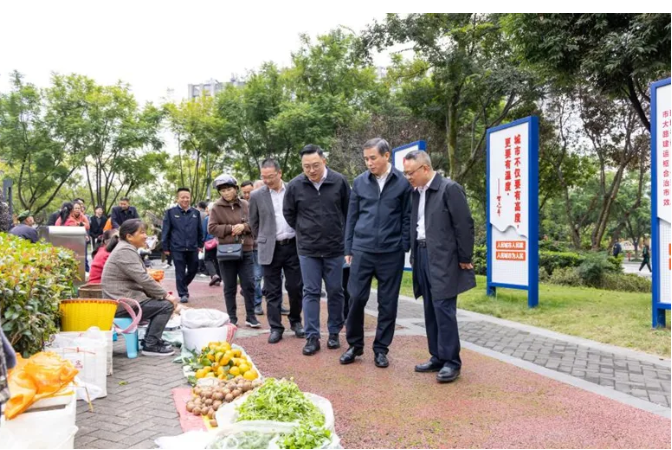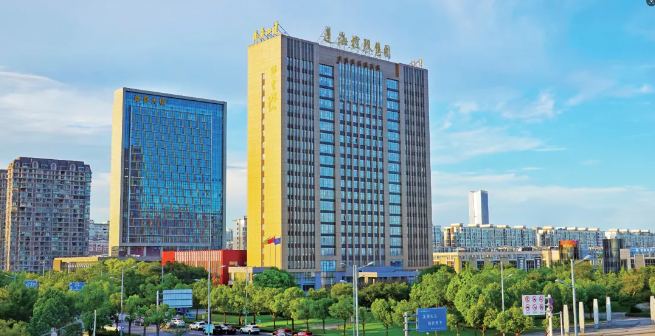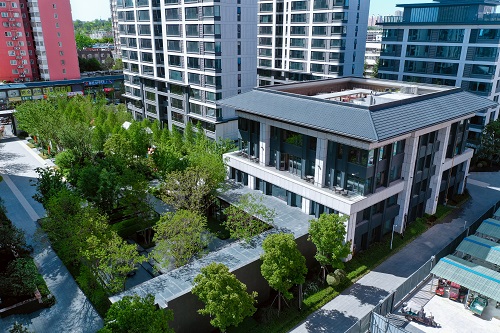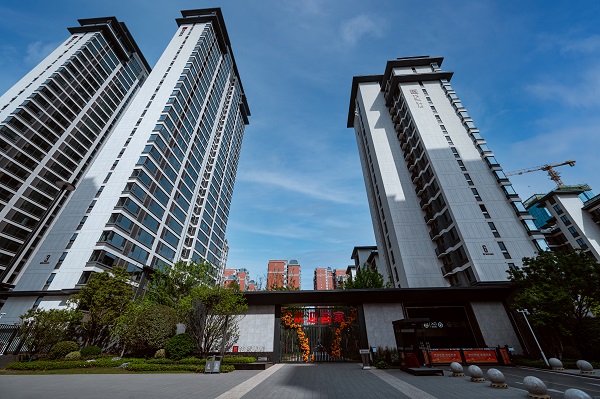塱头古村坐落在广州市北郊,建村至今已有六百余年。作为远近闻名的“书香科甲村”,塱头存有大量保存完好的书院、祠堂、民居、古巷等建筑空间。
The 600 years old ancient village of Langtou is located in the northern suburbs of Guangzhou. As a well-known "accomplished scholars village", Langtou has a large number of well-preserved old architectural spaces, such as academies of classical learning, ancestral temples, vernacular houses, streets and alleys, etc.
塱头古村 Langtou Village
比邻古村的艺文中心
A arts and cultural centre adjacent to the ancient village
横跨荷塘的步行桥将艺文中心与古村相连
A pedestrian bridge over the lotus pond connects
the arts and cultural centre with the ancient village
建筑融入风光旖旎的当地自然环境
The building blends into the
beautiful local natural environment
“塱”字的本意是江旁边的洼地,也引申为湖泽、池塘。古村被众多的水塘所环绕:荷塘、鱼塘、风水塘,微风拂过荷叶荡漾,俨然一派岭南水乡景象。我们设计的塱头艺文中心——“春阳台”正是立于村头的一片荷塘之中。
The word "lang" originally means the marshland next to the river, and its meaning also extends to lakes or ponds. The ancient village is surrounded by numerous ponds: lotus ponds, fish ponds, and Feng Shui ponds; when the breeze stirs the lotus leaves, it makes a beautiful scenery of Lingnan (south of the Five Mountains) water landscape. ChunYangTai we designed is situated in a lotus pond right outside the ancient village.
从入口侧俯瞰春阳台
Overlooking ChunYangTai from the entrance side
主入口 Main entrance
呼应历史尺度
Responding to the historic scale
为了与古村的尺度与格局形成对话,建筑采用聚落式格局,将项目所需的展览、阅读、观演、研学、餐饮等功能分散布置在十座小型单体建筑中。
Establishing connections with the scale and layout of the ancient village, the program of the complex – exhibition spaces, library, theater, research studios, and café – are dispersed into ten individual small building units.
入口楼梯 Entrance staircase
俯看下沉庭院
View of the sunken courtyard
单体建筑之间的弧形“楼”
"Towers" with curvilinear brick walls between building units
单体建筑通过弧形的“楼”相串联,同时也围合出尺度怡人的街巷与庭院。
Building units are connected by "towers" with curvilinear brick walls and form alleys and courtyards of intimate sizes in between.
下沉庭院里,展览入口(右侧)
Exhibition entrance (on the right) in the sunken courtyard
街巷 An alley
庭院 A courtyard
弧形“楼”作为单体建筑之间的过渡
Curved tower serves as transition between building units
楼内仰视 Look up inside the tower
楼内空间 Inside a tower
藏书楼 Library
亲子体验室 Children's playroom
从剧场室内看荷塘中可作为观众席和舞台的双向看台
The stand in a lotus pond that can be used as
audience seats /outdoor stage is seen from
the stage of the theater
可与户外联通的剧场
The theater can open to the outside
融入自然景致
Merging into the landscape
我们在建筑屋面设置了近三十组不同尺寸的种植池,其中茂盛的水生植物既是野趣的景观,也降低了建筑能耗。一条架空步道穿梭于屋面,从这里望去,种植池与下沉水院、周边的天然荷塘相互呼应,使春阳台成为一座融入环境、高低错落的 “立体荷塘”。
We have placed nearly 30 groups of planted water ponds on the roofs of buildings; the lush aquatic plants, primarily waterlilies, do not only form a natural landscape but also reduce the energy consumption of the buildings. The roof ponds, connected by elevated walkways, along with the ponds, both designed and natural ones, in the sunken courtyards and in the surrounding areas, create a "multi-level lotus pond system" that blends into the environment.
纵横的屋面架空步行道
Elevated walkways on roofs
屋面荷花种植池使建筑与自然荷塘浑然一体
The planted water ponds on the roof integrate
the architecture with the natural lotus ponds on the ground
步道的尽端将游人引入大自然
Ends of the walkway leads visitors into nature
从屋面架空步行道看荷塘及塘边村落
View of the lotus pond and the ancient village
beyond the trees from the elevated walkways
高低错落的立体荷塘
Planted ponds on different levels
建筑之间的水景
Water feature between buildings
承袭地域文化
Inheriting the local culture
建筑以古村中常见的红瓦、青砖为材,加上质朴的素混凝土,意在打造一处根植于塱头的乡土文化设施。
Local red tiles and traditional grey bricks are chosen the main building materials, together with exposed concrete, to create a local cultural facility that is rooted in Langtou tradition.
红瓦外立面 Red tile exterior
红瓦墙面细部 Red tile wall detail
从室内看镂空红瓦墙
A porous red tile screen-wall on the right and
a red tile wall on the left
红瓦外立面和青砖外立面
Red tile and grey brick exteriors
室内青砖墙面及天窗
Interior grey brick walls and skylight
混凝土楼梯和立面
Concrete stairs and walls
作为对“龙船脊”以及“月梁”等岭南建筑元素的当代演绎,建筑立面上的月牙形开窗既为建筑内部空间带来更加微妙和柔和的采光,又是观察环境的弧形画框,同时也是春阳台标志性的建筑符号。
As a contemporary interpretation of traditional Lingnan architectural elements such as "Dragon boat ridge" and "Moon beam", the crescent windows bring not only subtle and soft lighting into the interior spaces but also serve as an arc-shaped frame for observing the surroundings. It has become the iconic architectural symbol of ChunYangTai.
从月牙墙后看荷塘
Lotus pond seen from behind the crescent wall ©潘鸿
月牙窗 Crescent windows
华灯初上的餐厅
View of the lit café and dining at dusk
从荷塘遥看春阳台
View of ChunYangTai from lotus ponds
黄昏中的春阳台
ChunYangTai at dusk
———————— 图 纸 ————————
总图 Site plan
地下一层平面 Basement plan
一层平面 1st floor plan
二层平面 2nd floor plan
屋顶平面 Roof plan
剖面 Section 1-1
剖面 Section 2-2
剖面 Section 3-3
立图 Elevations
项目信息/Project Info
客户 / Client: 广东省唯品会慈善基金会/ Guangdong Vipshop Philanthropic Foundation
地点 / Location: 广州市花都区炭步镇塱头古村 / Langtou ancient village, Tanbu Town, Huadu District, Guangzhou
主持设计 / Principal Architects: 张永和,鲁力佳 / Yung Ho Chang, Lijia Lu
项目团队/Project Team: 程艺石,梁小宁,叶冬青 / Cheng Yishi, Liang Xiaoning, Ye Dongqing
设计合作/ Collaboration: 华南理工大学建筑设计研究院/ Architectural Design & Research Institute of SCUT
室内及常设展设计 / Interior & Exhibition Design:陸工作室,XL Studio,新纪元-成工作室,访落工作室 / Lu+Architects, XL Studio, Cheng Studio, Beijing Fangluo Studio
景观设计 / Landscape Design:广州怡境景观设计有限公司 / GVL Group
照明设计 / Lighting Design:栋梁国际照明设计 / Toryo International Lighting Design Center
建筑面积 / Building Area: 8602 ㎡
基地面积 / Site Area: 7217 ㎡
建筑高度 / Building Height: 12 m
设计时间 / Design Period: 2021
竣工时间 / Completion Time: 2023
摄影师 / Photographer:田方方 / Tian Fangfang





发表评论 取消回复